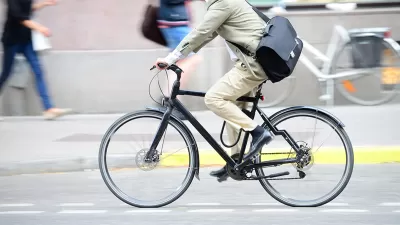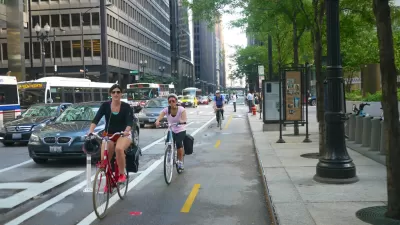Many U.S. cities are seeing an increase in bicycle commuters, according to a U.S. Census Bureau report released last week. Of all commute modes, biking increased the most from 2000 to 2012. Walking, however, held steady.

"Nationwide, the number of people who traveled to work by bike increased roughly 60 percent over the last decade, from about 488,000 in 2000 to about 786,000 during the 2008-2012 period. This is the largest percentage increase of all commuting modes tracked by the 2000 Census and the 2008-2012 American Community Survey," according to a press release announcing the United States Census Bureau's new report, titled "Modes Less Traveled—Bicycling and Walking to Work in the United States: 2008–2012."
Moreover, "[while] bicyclists still account for just 0.6 percent of all commuters, some of the nation's largest cities have more than doubled their rates since 2000. Portland, Ore., had the highest bicycle-commuting rate at 6.1 percent, up from 1.8 percent in 2000. In Minneapolis, the rate increased from 1.9 percent to 4.1 percent."
The results for walking, however, held steady: "After steadily decreasing since 1980, the percent of people who walk to work has stabilized since 2000. In 1980, 5.6 percent of workers walked to work, and that rate declined to 2.9 percent by 2000. However, in the 2008-2012 period, the rate of walkers remained statistically unchanged from 2000."
On the same day as the study, the Census also released a new commuting edition of the interactive map Census Explorer. Planetizen blogger Michael Lewyn already crunched that data about average commute times in cities and suburbs around the country.
Michael Stenzel has also analyzed some of the data in the report, especially with regard to the growing rate of walking and biking to work in Chicago: "In Chicago in 2000, 5.7% of workers walked to work, but by 2012, the percent had increased to 6.4%," and "in 2000, only half a percent of Chicagoans rode their bikes to work, but by 2012, it was 1.3%."
FULL STORY: Biking to Work Increases 60 Percent Over Last Decade, Census Bureau Reports

Maui's Vacation Rental Debate Turns Ugly
Verbal attacks, misinformation campaigns and fistfights plague a high-stakes debate to convert thousands of vacation rentals into long-term housing.

Planetizen Federal Action Tracker
A weekly monitor of how Trump’s orders and actions are impacting planners and planning in America.

In Urban Planning, AI Prompting Could be the New Design Thinking
Creativity has long been key to great urban design. What if we see AI as our new creative partner?

King County Supportive Housing Program Offers Hope for Unhoused Residents
The county is taking a ‘Housing First’ approach that prioritizes getting people into housing, then offering wraparound supportive services.

Researchers Use AI to Get Clearer Picture of US Housing
Analysts are using artificial intelligence to supercharge their research by allowing them to comb through data faster. Though these AI tools can be error prone, they save time and housing researchers are optimistic about the future.

Making Shared Micromobility More Inclusive
Cities and shared mobility system operators can do more to include people with disabilities in planning and operations, per a new report.
Urban Design for Planners 1: Software Tools
This six-course series explores essential urban design concepts using open source software and equips planners with the tools they need to participate fully in the urban design process.
Planning for Universal Design
Learn the tools for implementing Universal Design in planning regulations.
planning NEXT
Appalachian Highlands Housing Partners
Mpact (founded as Rail~Volution)
City of Camden Redevelopment Agency
City of Astoria
City of Portland
City of Laramie





























